In the midst of what was now a two-front war, Hitler and a select group of trusted officials proceeded with the Final Solution, a systematic killing of Jewish people and others deemed "undesirable." Hatred of Jewish people was high among the tenets of the Nazi Party, and this drove the development of programs to not only imprison but also eliminate millions of people. The targeting of Jewish people is also known as the Holocaust. As it happened, distrust of Jewish people was not new; at many times since the days of the Roman Empire, Jews had been the target of malignment, mistreatment, malice, and mayhem. As early as 1933, the German government had announced a one-day boycott of Jew-owned businesses. Two years later, as part of the Nuremberg Laws, Jews were stripped of their German citizenship. They could live in Germany, but they could no longer enjoy the benefits of being citizens. In 1936, German Jews were told that they could no longer vote. Two years later, they were told that they had to carry identification cards, so everyone would know what religion they practiced.  German non-Jews blamed the Jews for many things, including Germany's defeat in World War I and the economic collapse that followed. The intense violence began on October 28, 1938, when German police arrested 17,000 Jews originally from Poland and sent them back to Poland, without their belongings. Poland didn't want them, either, however, and so the people were put into a "relocation camp," along the border separating Poland and Germany. On November 9, mobs stormed throughout Germany, Austria, and the Sudetenland, attacking Jewish people in public, in their homes, and where they worked. They even attacked the places of worships, the synagogues. The violence continued the next day. When it was done, nearly 100 Jews had been killed and hundreds had been hurt. More than 1,000 synagogues were burned. More than 7,000 Jew-owned businesses were destroyed. Most disturbingly, more than 30,000 Jews were arrested and sent to concentration camps, advanced versions of prisoner-of-war camps begun in other countries at the turn of the century. Because of the attacks on businesses and the number of broken store and house windows, the first night of the attacks has come to be called Kristallnacht, "the Night of Broken Glass." 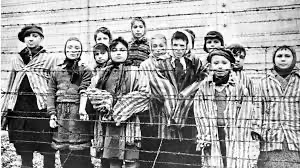
The people sent to concentration camps found themselves enduring nightmarish conditions, from their initial imprisonment through their time imprisoned. They were given little food and were expected to do back-breaking labor day in and day out. Estimates are that the number of concentration camps exceeded 1,000. Among those camps were these major ones: Arbeitsdorf, Auschwitz, Belzec, Bergen-Belsen, Buchenwald, Dachau, Flossenburg, Gross-Rosen, Herzogenbusch, Hinzert, Kaiserwald, Kauen, Krakow-Plaszow, Majdanek, Mauthausen, Mittelbau-Dora, Natzweiler-Struthof, Neuengamme, Niederhagen, Ravensbruck, Sachsenhausen, Stutthof, Valvara, and Warsaw. In the early days, members of the German Communist Party made up the majority of the concentration camp population. As time went on, the German government imprisoned others viewed as enemies of the state, including members of political parties other than the Nazi Party. Although German people (primarily Jews but people of other faiths as well) were frequent occupants of these concentration camps, they made up, as the war went on, the minority. Many people died in these conditions, for a variety of reasons. Most prevalent were disease and malnutrition, as camp conditions were far from sanitary and supplies of food and medicine were far from adequate. A great many prisoners died as a result of work that they forced to do. 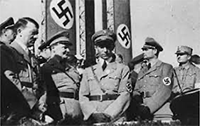
Driving the preeminence of the Nazi Party was the paramilitary organization the Sturmabteilung, abbreviated to SA. Armed members of the SA provided protection for Nazi leaders at rallies and also occasionally stormed meetings of other political parties. The SA uniform was largely brown in color, and members of the SA became known as Brownshirts. Another paramilitary group serving the Nazi Party needs during this period was the Schutzstaffel, abbreviated as SS. Members of the SS on July 2, 1934, carried out a series of executions of dozens of SA leaders known as the Night of the Long Knives. The SS then took over the running of concentration camps, which the SA had done. Near the end of 1941, Hitler ordered the concentration of extermination camps, in Germany and in conquered territory. Concentration camps at Auschwitz and Majdanek became extermination camps; to those the Nazis added Belzec, Kulmhof, Sobibor, and Treblinka. A common means of extermination was the gas chamber, which appeared in these camps by the middle of 1942. Estimates are that the Holocaust death toll among the Jewish population exceeded 6 million. 
On the war front, Hitler, convinced of German superiority, refused to listen to his other commanders' advice on many occasions and fought off calls for retreat or redeployment; as a result, the Soviet Army found itself on the winning side of the long and drawn-out Battle of Stalingrad and of the Battle of Kursk, the largest tank battle in human history. Earlier in 1942, the superior German technology and strategy was not enough to defeat a resurgent Allied force at El Alamein, North Africa; that defeat ended Hitler's plans to seize the Suez Canal. Commanding the Allied troops at the Second Battle of El Alamein was U.K. Lieutenant-General Bernard Montgomery. Among that Allied force were troops from the United States, which had been in the war since the Japanese attack on Pearl Harbor on December 7, 1941. Again showing overconfidence, Hitler four days later declared war on the United States. American troops bolstered the Allied defense of North Africa and lands in the Mediterranean. Turning back the Axis tide, Allied troops invaded Sicily in 1943 and convinced Italy's King Victor Emmanuel III to remove Mussolini from power and surrender to the Allies. As a result, Hitler sent even more troops into Italy, to try to hold it. 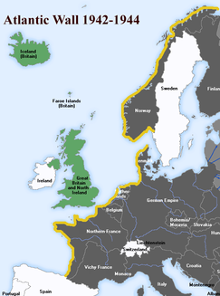
Beginning in 1942, Germany had impressed nearly a million French workers into building a large system of coastal fortifications along the Atlantic coastline of France, especially, but also Belgium, Denmark, Norway, and the Netherlands. The more than 1,500 miles of fortifications took the form of walls, fences, and were punctuated by deadly means of defense such as guns, artillery, and mortars. Overseeing the construction of the Atlantic Wall and its defense were thousands of German troops. Patrolling the Atlantic were a large number of German ships as well. Because of the early success of the German navy in patrolling the Atlantic, Allied attacks targeting the Atlantic Wall were few and far between in the first few years of its existence. As the tide turned more and more in the Allies' favor, German forces prepared for an Allied invasion of Europe. The German high command assigned first Field Marshal Gerd von Rundstedt and then Field Marshal Erwin Rommel to reinforce the defenses. The dawn of 1944 brought with it more German defeats. Soviet troops were slowly but steadily advancing in the east, and Allied forces were making gains in the South. British and American planes began bombing German troop positions, while Allied armies solidified their gains in Italy. The U.S. began sending men and weapons and ships and tanks in record numbers to Britain, in preparation for a massive invasion. That this was possible at all was due to the Allies' finally breaking the grip on Atlantic shipping lanes of the vaunted German U-Boats, which had long harassed transports and other sailing vessels. Sailing in "wolf packs," these submarines proved expert at sinking Allied ships for the first few years of the war. By 1944, however, Allied ships ruled the Atlantic. At the same time, Allied forces engaged in Operation Fortitude, a sleek act of deception that fooled the German Army for weeks. Through a series of intelligence "leaks" and the construction of dummy tanks, planes, and landing craft, the Allies had Hitler and his commanders convinced that the target for the intended invasion was Pas-de-Calais, the nearest point to the United Kingdom and that leading that invasion would be America's celebrated General George Patton, at the head of the First United States Army Group. 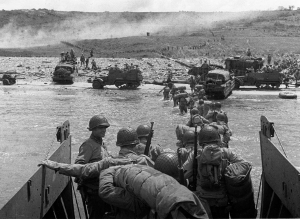
On June 6, 1944, the largest amphibious attack in history, known as the D-Day landings, proved successful, bursting the superiority of Hitler's Fortress Europe. The landings occurred at Normandy (not Pas-de-Calais); and leading the invasion was Dwight D. Eisenhower. Operation Fortitude was so successful that the German Army kept 15 reserve divisions near Calais even after the "real" landings took place. Capitalizing on this element of surprise, Allied troops established a beachhead and then ground their way inland. In a matter of weeks, Allied troops were taking control of France and the Low Countries and making their way eastward toward Germany. Hitler, unsurprisingly, was enraged. As things grew more and more grim for Germany's war plans, many military officers urged Hitler to negotiate for peace. His refusals persuaded some to embark on a more violent solution. Hitler foiled several assassination plots during the war. The most well-known was likely Operation Valkyrie, spearheaded by a German army officer's attempt to kill the Führer with a bomb in his headquarters in July 1944; that plot failed as well. In response to the continued Allied advance, Hitler ordered a large-scale counter-offensive, known as the Battle of the Bulge, in December 1944. The German attack succeeded for a time but was eventually turned back. Hitler continued to insist that the Third Reich was destined to be victorious; the results on the battlefields of Europe continued to suggest otherwise. Hitler retired to the A week later, Hitler and Eva Braun, his longtime companion whom he had only recently married, were dead, by their own hands. Allied forces took Berlin on May 2; five days later, Germany surrendered unconditionally. |
|
Social Studies for Kids
copyright 2002–2026
David White



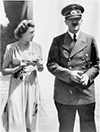 Chancellor and its subterranean bunker, continuing to issue desperate orders. By April 23, the Red Army was in the streets of Berlin.
Chancellor and its subterranean bunker, continuing to issue desperate orders. By April 23, the Red Army was in the streets of Berlin.
